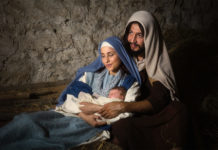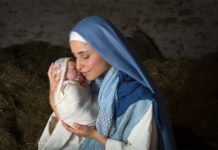Some Christians venerate the Virgin Mary, multiplying her attributes and exaggerating her qualities to the point of deification. Other Christians go to the opposite extreme and trivialise Mary’s personality and contribution, barely recognising her basic qualities.
In the first case, the biblical perspective on God is affected. In the second case, the mystery of incarnation is trivialised.
Worshipping the virgin Mary, throughout history
Christians have always had a special respect for the one who gave birth to the Saviour. The Bible portrays Mary, Jesus’ mother, as a humble person, highly spiritual, dedicated to her Son (Matthew 12:46-49), and quiet.
The passing of the centuries has brought Mary’s representation to a “necessary deepening, corresponding to the evolution of the people’s mentalities from different historical eras”[1].
Over time, a conceptual transition was made from the real character described in the Bible to the imaginary embellished character—the cult object. The difference is obvious when we read about Mary’s apparent claims to receive certain praise or the domineering (even despotic) attitude in some of the accounts of her miracles.[2]
During the Council of Ephesus in 431 AD, the Church officially approved the teaching that the Holy Virgin is the Mother of God (theotokos, Gr.) and that she deserves special honour. During this council, Nestorius, the bishop of Constantinople, was declared a heretic because he argued for two distinct persons of Christ and refused to call Mary theotokos, a term which had been accepted by some Christians almost a century before the Council of Ephesus. Therefore, the term evolved from popular devotion to the agenda of the Council of Ephesus, according to the principle “the law of what is prayed is the law of what is believed”[3].
Descendants of Cyril of Alexandria (an opponent of Nestorius) took the next step. They believed that the Saviour was one person with an exclusively divine nature (Monophysism). Minimizing Jesus’ humanity to the point of denial led to the prospect of Christ’s detachment from mankind. Thus, the Monophysite theologians set out to search for a new aspect to bridge the created and the uncreated. In this way, the appearance of the feast “The Dormition of the Mother of God” came to be justified in 5th-century Monophysite circles as a celebration that consecrates, exemplifies, and demonstrates the need to worship the virgin Mary. The holiday was inspired by an apocrypha, The Book of John on the Dormition of the Mother of God, dating to no earlier than the 4th century.[4] The feast was centred around a procession along the road between Zion and Gethsemane, to a church which was believed to have been built on the site of Mary’s tomb.
The Patriarch of Constantinople, Timothy I (511-518), was well aware of the potential number of pilgrims who would gather from across the empire to observe this event. So, he introduced this holiday in the Byzantine capital, during the time of Emperor Athanasius I (491-518). Inspired by the church in Vlaherne, where Mary’s alleged shroud is located, he created a procession to the Church of the Virgin in Chalkoprateia, where Mary’s supposed girdle is found.
During the reign of Emperor Justinian (527-565), the Orthodox Church took over the Monophysite Church in Gethsemane and the celebration of the Dormition. The Emperor Mauricius (582-602) built a new church in Gethsemane (590-591), changed the ceremonial date and established the celebration of the Dormition of the Mother of God on the 15th of August.
At the end of the 7th century, John, bishop of Thessalonica, records the inexistence of the feast of the Dormition of the Mother of God in his diocese, and the desire to introduce this feast in order to enhance the cult of the Virgin Mary. This is how the Virgin Mary came to be venerated throughout the Christian world.
The virgin Mary: making up for God’s apparent apathy
The development of the Virgin Mary’s hyperdulia (the level of reverence the Catholic Church reserves exclusively for Mary) appeared against a spiritual backdrop marked by the widespread perception of holy distance, i.e. by an “impossible space” between humans and God. But it ignored an important implication of the Saviour’s sacrifice: “…we have confidence to enter the Most Holy Place by the blood of Jesus” (Hebrews 10:19). It should be noted that the verb is used in the present tense. Therefore, Biblical theology does not allow for a distance between Christians and God; not now, nor in the future.
Still, for the Monophysites this holy distance grew ever larger, while for the Orthodox Church it stayed on a rather moderate level (one could draw nearer to God by virtue of one’s deeds).
The development of the Virgin Mary’s hyperdulia appeared against a spiritual backdrop marked by the widespread perception of holy distance, i.e. by an “impossible space” between humans and God.
Orthodox theologian Vladimir Lossky recognizes the desire of Eastern piety to secure the connection between man and God by building a new bridge: “Therefore, to the devotion of Christians to an incarnate divine hypostasis, Jesus Christ, the piety for a deified human hypostasis is added: Mary, whom St. Gregory Palamas calls ‘the threshold between the created and the uncreated.’”[5]
The same idea is expressed by Father Teofil Parapianu when he talks about an additional hope: “What is the Mother of God for us? Hope, increased hope! Why? Because we need her help, her protection, her covering, her intercession and her prayers. We have additional hope. The Mother of God is hope: ‘All my hope I place in you, Mother of God, place me under your protection’”[6] Father Teofil emphasizes the anguish of the orthodox believer, who yearns for Mary’s presence as an addition to his hope. To the question of why Mary must play this role, he answers: “…because this is what our Church teaches us!”[7]
When an Eastern-Orthodox Christian or a Catholic talk about receiving divine help, they profess to have been helped by the Virgin Mary and God. Mary is associated with every blessing. When they think about death and the last judgement, their hope is primarily rooted in Mary’s intercession. Where does this need for assurance come from? Could it be a popular misconception that Mary’s motherly heart is more empathetic than God’s fatherly one?
Fatherly vs motherly love
When they love, mothers do so unconditionally. Mothers are not content to love their children as they love other things—they love them instinctively. If there is hurt, a mother’s love will offer more love, more care, more tears, and more prayers[8].
Our image of our Heavenly Father bears tragic inaccuracies because people use the paternal model of their own culture as a reference, and not what the Holy Scriptures actually tell us about God.
Our image of our Heavenly Father bears tragic inaccuracies because people use the paternal model of their own culture as a reference, and not what the Holy Scriptures tell us about God.
In the natural understanding, without studying the Bible, God does not have a mother’s heart because… He’s a Father. This is where the idea that the impossible space between man and God can only be filled by a deified Mother comes in.[9] This is why Mary is vested with inexhaustible qualities and functions in relation to her Son. Christians have developed Mary’s imaginary person so much that they have turned her into the personification of the emotional capacity that the Father seems to lack. Involuntarily, Mary is associated with the Trinity (completing the love of the Trinity; in iconography she is crowned by the Holy Trinity as Queen of Heaven).
God’s heart—a biblical perspective
From the Bible’s perspective, God is perfect, multidimensional love (1 John 4:16). God loves like a Father: “As a father has compassion on his children, so the Lord has compassion on those who fear him” (Psalm 103:13). However, He can also love like a mother: “Can a mother forget the baby at her breast and have no compassion on the child she has borne? Though she may forget, I will not forget you!” (Isaiah 49:15; 44:2-5). Furthermore, God’s love rises above all love categories. He loves like a God: “The Lord appeared to us in the past, saying: ‘I have loved you with an everlasting love; I have drawn you with unfailing kindness'” (Jeremiah 31:3).
We cannot say that someone can love more than God, that there is someone who cares about us more, or that there is someone who is more interested in our salvation. There’s no room for another person between us and God’s love, not even the Mother of God, because such space does not exist: “For I am convinced that neither death nor life, neither angels nor demons, neither the present nor the future, nor any powers, neither height nor depth, nor anything else in all creation, will be able to separate us from the love of God that is in Christ Jesus our Lord” (Romans 8:38-39).
Much respect is owed to the Mother of God, for her person and her role as our Lord Jesus’ mother. However, she did not interfere with her Son’s saving mission. The intercessory capacity that is often ascribed to her by the Christian imagination cannot belong to her. This work belongs exclusively to the Lord Jesus Christ because it is based on the fruit of Calvary (Revelation 1:4-6). This last text shows us the full love of the Holy Trinity, which we must fully trust in.

















